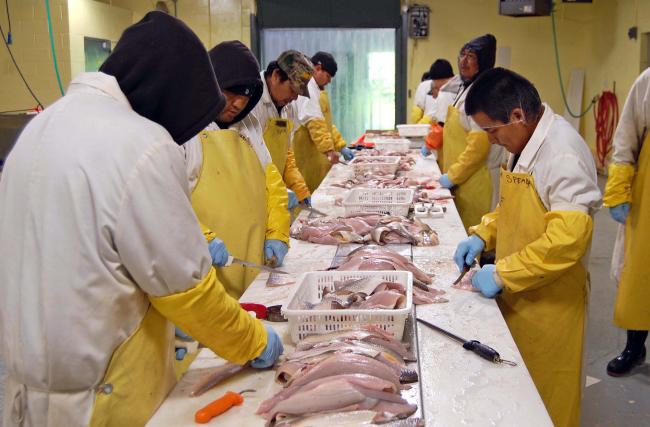The last time you were at your favorite fishmonger or raw bar, you probably watched in admiration as your order was expertly filleted or shucked to order. Those skills are in equally high demand at large-scale seafood processing plants, albeit in less romantic conditions. Even in an era of modern industrial equipment, many types of seafood require delicate handling to shuck oysters, crush crab claws and debone herring. However, the supply of people who are willing to take these jobs is shrinking with every passing year. Despite record high unemployment rates, the repetitive manual labor, cold working conditions and modest wages are a turn-off for many prospective workers. Farmers face many of the same challenges in finding labor. The end result? Processing plants in the U.S. rely on an unpredictable supply of temporary guest worker from foreign countries to fill positions. This begs the question: what will it take to create sustainable, equitable jobs in the seafood industry again?
Currently, the seafood processing industry’s entry-level positions are filled by the visiting worker program, which places strict limits on the number of visas issued and the duration of work. The bureaucratic hurdles and labor shortages make it difficult to forecast production, much less have a long-term business plan. It wasn’t always like this, noted Brandii O’Reagan, a quality-assurance manager at Icicle Seafoods in Alaska. “When I started, when we were hiring people, there was a row of 80 college kids with their backpacks, lining up to work for $6.40 an hour,” she says. “Now we’re starting them at $7.25, 20 years later” and the money they stand to make might not “get them up here and back home again. We don’t have Americans anymore; 80 to 90 percent are Hispanic or J-1s from Eastern Europe.” There simply aren’t enough people domestically to fill these jobs.
If workers aren’t attracted to these physically taxing positions, why not raise wages? The answer is not so simple. Cheap labor and stiff competition from Asia means companies are hard-pressed to pay workers more. While domestic workers are paid hourly amounts just above minimum wage, workers overseas are paid a fraction of those costs. To further complicate matters, 85% of the seafood consumed by Americans is now imported from abroad (up from 50% in 1991). Not only is the cost of labor in developing countries significantly lower, but it is cheaper to process and package seafood near the location it is caught or raised. In combination with the moribund U.S. economy, seafood producers are reluctant to pass on any additional costs to their customers, which means raising wages is not a viable business option. “Whatever the magic number is, $11, $12, or $20 an hour, the other half of the equation is the American consumer affording that product,” says Gary Bauer of Pontchartrain Blue Crabs. “It’d make it out of reach.”
Element Seafood works with a number of small-scale, independent shellfish farmers, who are small enough that they don’t need to hire much outside help for their harvests. However, this is unusual in the industry, and as businesses develop, they all face the same struggles for staffing that hamper their growth.
Ultimately, these issues can only be solved by broad food system changes, such as fair wages in Asia, liberalized immigration policies to make it easier to fill domestic positions, and educated consumers who value and are willing to pay a premium for locally caught and processed seafood. Would you be willing to pay extra for domestically produced crab meat? How much more?
